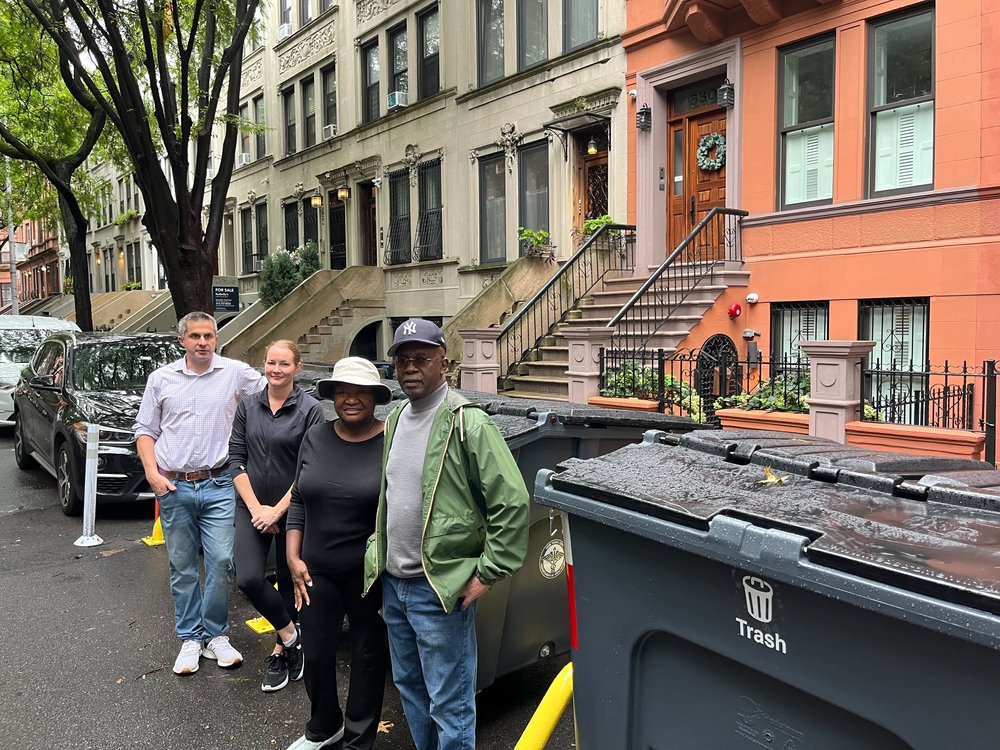West Harlem residents say new shared trash bins are an ‘ugly’ sight on historic block
Sept. 20, 2023, 4:18 p.m.
New dumpsters have been installed in an area of Upper Manhattan as part of a pilot program to keep trash bags off the sidewalks.

Residents of historic buildings on a tree-lined section of Upper Manhattan found a new feature in their neighborhood last week: large wheeled bins labeled "Trash."
The sanitation department installed the shared dumpsters on residential streets in West Harlem as part of a pilot program inspired by operations in cities like Barcelona and Paris, where residents throw away trash in communal bins instead of leaving bags on sidewalks for collection. Officials say the goal is to reduce the city's exploding rat population by eliminating the rodents' access to food sources in household trash.
Caroline Miller, who lives with her husband on West 149th Street, said the dumpsters were set up outside her first-floor apartment without community input.
“I hate them so much. It is ridiculous. We got no notice, we got no say,” said Miller, a 36-year-old opera singer. “You pay a certain amount of rent for, like, a pretty, cute neighborhood feeling. Now it's like I'm living in the back alley of a school building.”
“Can you imagine this being allowed on the Upper East Side? No way,” she added.
The bins were installed in clusters last week on each residential block between West 142nd and West 144th streets and between West 146th and West 153rd streets, from Broadway to Amsterdam Avenue. The large containers were also installed outside several public schools in the neighborhood last month.
The sanitation department has halted curbside collection of trash bags in the pilot area. Crews now only pick up trash thrown in the new containers.

Adam Young, 43, who also lives on West 149th Street, said a city employee gave him a flier notifying him of the new rules and that the new bins would be coming to his block. But he said no further information was offered until he discovered three bins and yellow metal railings installed directly in front of his family’s Romanesque-style building.
“Obviously they did no research. They didn't study the effect on the community. They didn't talk to anyone in the community,” said Young, who works in finance.
In a statement, sanitation department spokesperson Vincent Gragnani said the department conducted extensive outreach before launching the program, and that the pilot dumpsters will not be the final design.
“We have knocked on doors, hosted information sessions, sent mailers, attended community meetings — and the majority of residents we spoke with had positive feedback to offer,” said Gragnani.
“No community outreach was done over the last several decades to ask residents whether they wanted piles of smelly black trash bags piling up on their sidewalks, day after day, night after night, sometimes sitting as long as 36 hours before being picked up,” he added.

Councilmember Shaun Abreu, who represents the neighborhood, said he’s heard mostly support for the pilot program from the community — but acknowledged some of the directly affected residents may have to “make a sacrifice for the greater good.”
“At the end of the day, we are part of a larger community,” he said. “A rollout is never going to be perfect. But I can tell you that from what I'm hearing in our office, and from constituents, a majority of people are excited about this change.”
As part of the pilot, trash is collected from the bins six days a week instead of three. But Deborah Woodberry, 72, who lives across the street from Young, said that’s a problem because she’s frequently woken up by garbage trucks before 6 a.m.
“I'm a light sleeper. And I hear most of the noise when they come along,” said Woodberry, a retired teacher.
Gragnani said the early morning pickups are part of a larger strategy citywide to collect trash faster.
“We have been picking up the majority of New York City residential trash on the 5 a.m. shift since the spring. This is not unique to the containerization pilot, but rather an effort to reduce the number of hours that all trash sits on the street,” he said.
Deborah’s husband Willie Woodberry, 78, was convinced the bins would become a site for illegal dumping. “It's just a matter of time,” he said. “You find a dumpster someplace, you put whatever in it – and that's what's going to happen with this here.”
At least one New Yorker who frequents the area thought the bins were a good idea. Theresa Copeland, who used to live in Harlem and often visits her son on West 149th Street, said keeping garbage bags off the sidewalks is a good way to rid the neighborhood of rats.
Copeland said she had an unfortunate rodent run-in while visiting her son recently.
“I almost stepped on a rat. I must have had a fit,” she said.
She nodded approvingly at the bins. “It looks better to me. I like it,” Copeland said.
Still, many residents on West 149th Street felt the neighborhood was unfairly selected for the program.
“They probably thought that they could come into Harlem and exploit the people up here because we won't fight back,” Young said.
Miller’s husband Jesse Markowitz, a 35-year-old data scientist who works from home, said he supports the city’s efforts to containerize residential garbage. But he finds the new bins to be an eyesore on an otherwise picturesque block.
“I think that the goal is worthwhile,” he said. “That's why the more I think about it, the more I'm just disappointed that they look so bad … just, like, why does it have to look so ugly?”
Giant trash bins land in Harlem: Will they fight rats or just take up parking?